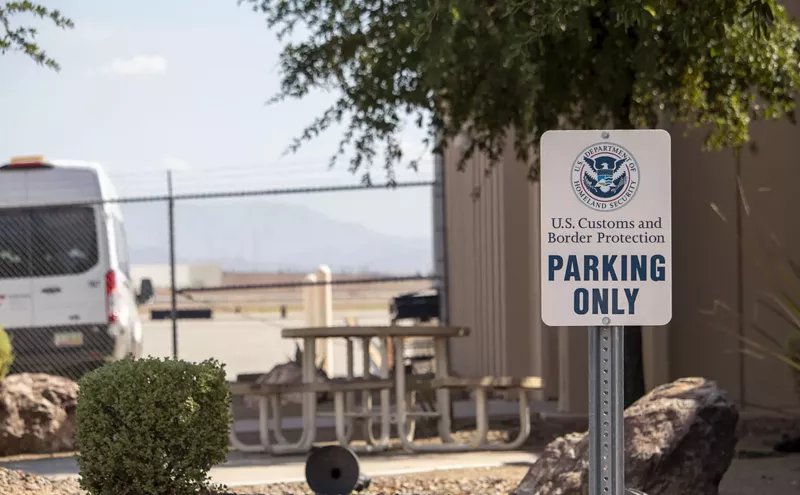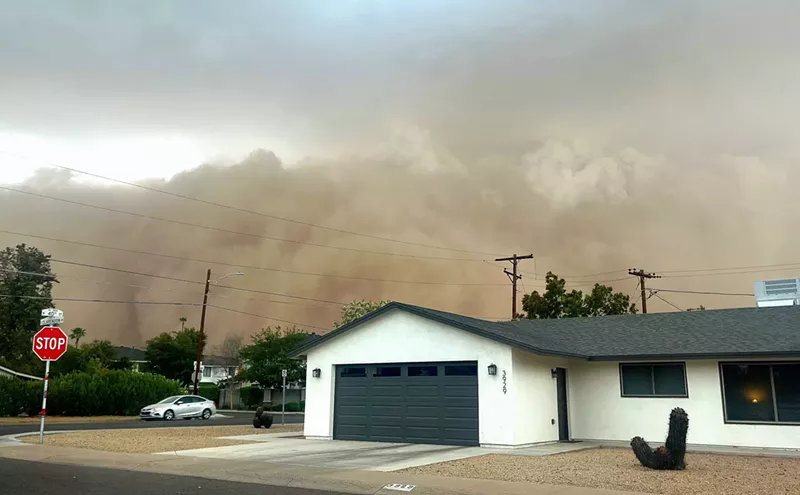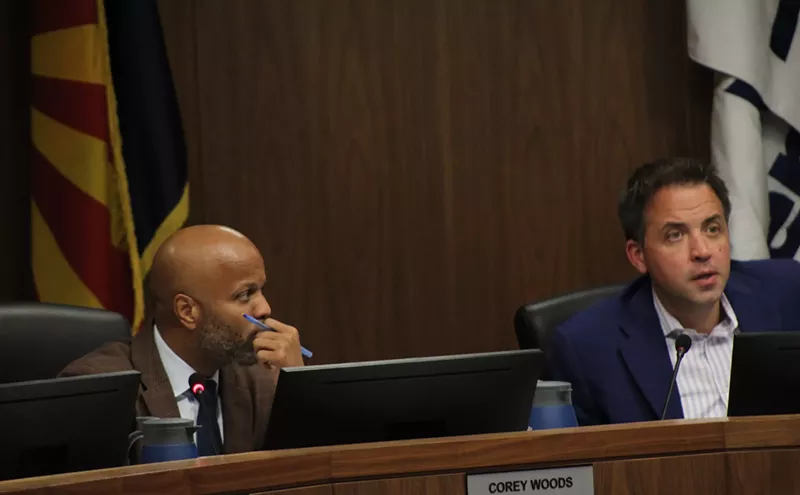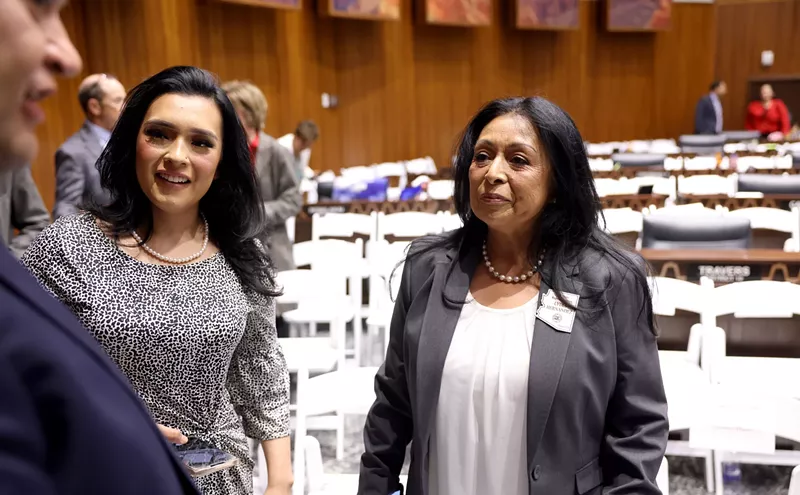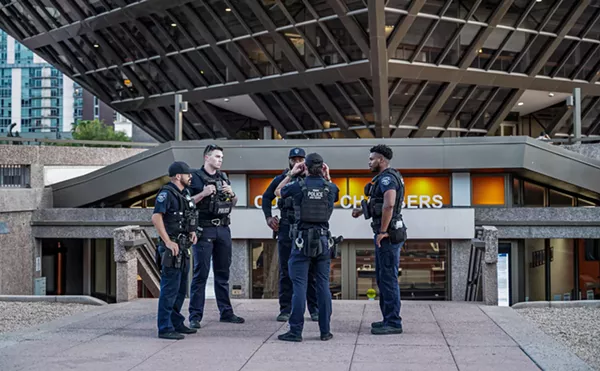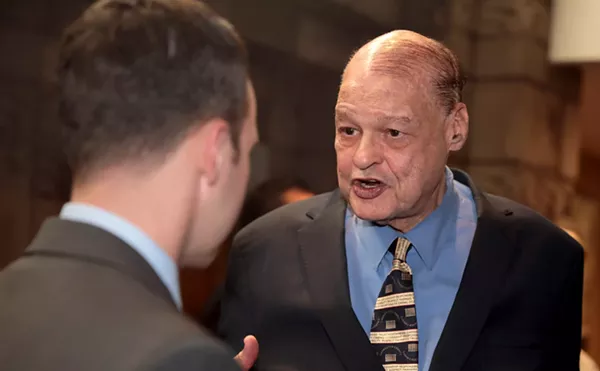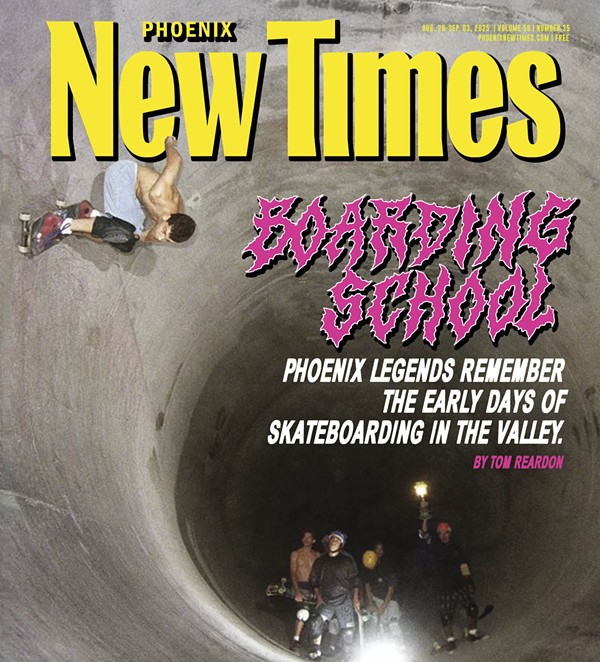She found a "fixer-upper" home in an old Mesa neighborhood, saw its potential and bought it for a bargain price without giving much thought to the blight that surrounded it.
She fixed up the house, painted at her easel and learned to subsist in a cocoon, insulating herself from the sound of gunshots and sirens that echoed through the night. But when her neighbors, desperate to alter the environment that was victimizing so many of their children, begged her to help, Tittle-Baker agreed to see what she could do.
What she has done--almost exclusively through grassroots organizing, networking and obtaining donations and grants--is miraculous. When former Reagan/Bush speechwriter Peggy Noonan penned the term "a thousand points of light," she must have envisioned Bev Tittle-Baker.
"If we had about a hundred more citizens like her, we wouldn't have any problems in Mesa," says Tanya Collins, director of Mesa's Neighborhood and Community Assistance Office.
Statistics say a lot about Tittle-Baker's neighborhood. She can pull out data showing the poverty-level incomes, the number of children in single-parent homes, the number of students for whom English is a second language, the high percentage of gang members.
But no statistics reveal as much as a neighborhood stroll with Tittle-Baker.
The sun is creeping toward the horizon as we begin to walk south on Bellview, the street where Tittle-Baker, 51, and her husband of two years, Robert Baker, live in a quaint brick home that could have been torn from the pages of Country Living.
The first people we encounter are young Latino men, gathered around their cars, drinking 40-ouncers and blasting hip-hop. She whispers that "the house looks suspicious" because of the high volume of traffic. The occupants have moved in recently, so she doesn't quite have a handle on their activities. This is unusual; Tittle-Baker knows almost everyone in the area. If she doesn't know the adult residents, you can be sure that she knows the children.
Not far from the "suspicious" house, a couple of boys are playing in their yard. She tells me of their father's history of physically abusing the boys and that he was recently accused of sexually molesting the boys' younger sister. The boys call out a greeting. She responds warmly and asks them why they weren't at the after-school program that day. They explain that the family had to take the younger girl to the hospital for her asthma.
All the kids in the area know who Bev Tittle-Baker is--she's the lady who opens her home to them after school every day from 3:30 to 5. They do arts and crafts, play games and have snacks out of the food-bank shed adjacent to her backyard.
The seeds that sprouted into the after-school program were sown in the summer of 1995 by a group of teenage girls who would walk the younger children to a school and back each day to partake of the free breakfast/lunch program. The children would convene at Tittle-Baker's home to meet their escorts; after a short time, the older girls wanted to have activities for the children.
Tittle-Baker was more than accommodating--ever since then, kids have gathered in the afternoons in her backyard, year-round.
On a recent afternoon at "Club Bev," about 30 kids ages 2 to 17 congregated in her yard. In her kitchen, an intern from Arizona State University's School of Social Work mixed homemade modeling clay in the sink. While the intern squished paint into globs of flour and salt, Tittle-Baker rummaged through the food shed for empty egg cartons, drinking straws and dry kidney beans.
Locating her "educational materials," she demonstrated the game she has planned for the younger kids that day. She numbered the depressions in the egg cartons and poured kidney beans into the open lid. The kids were to suction the kidney beans with the straw and drop them into the depressions until the number of kidney beans in each cavity matched the number marked above it.
The modeling clay was brought from the kitchen to picnic tables and the kids picked through the colors voraciously. "I don't want pink!" one young boy yelled. While the kids kneaded and molded their balls of dough, Tittle-Baker and her volunteers brought out seashells, beads and plastic jewels to add to the kids' sculptures.
As the projects began, an 8-year-old boy rode up on a bike, announcing, "More kids coming," first in English, then Spanish. The children were equally Latino and Caucasian, reflecting the near equal residency of the races in the neighborhood.
Tittle-Baker walked around, encouraging the kids. One brash 6-year-old hoisted his sculpture and declared, "I'm keeping this!" Tittle-Baker sweetly encouraged him, saying, "Why, I would, too. That's a wonderful piece."
For the most part, the kids focused on their projects, polite and respectful to Tittle-Baker and the volunteers.
The sculptures were put on hold while a volunteer distributed fried chicken to the children. Tittle-Baker stood to the side and talked about some of the children present.
"I don't have a child here who's not high-risk," she said.
She pointed to a smiling, dirty-faced 4-year-old whose apparent hearing problems prevented him from talking until about six months ago. He talks enthusiastically now, if not very clearly. Tittle-Baker pointed out his sister, an 8-year-old redhead who has a brain tumor.
She noted a couple of kids who were placed into the custody of their grandmother because their mother was dealing drugs. "Those kids were rolling her joints at the age of 5," Tittle-Baker said.
Some of the others in the yard were born addicted to drugs, she explained. Several have learning disabilities. She gestured toward a teenage boy, there to help with the kids, who's on probation for assault.
"What keeps me from burning out is the kids," Tittle-Baker explains. "No matter how bad the political fights or anything else might be, all I need is for one of them to come knocking at my door, and that rejuvenates me. I think, okay, I've won this."
Next fall, the ASU schools of Social Work and Nursing will send students to assist at the after-school project and work one-on-one with families in crisis. Dr. John Michael Daley, a professor of social work at ASU, arranged the program. From the beginning of Tittle-Baker's efforts, he has served as her unpaid, informal consultant.
"These people (in the Bellview neighborhood) aren't asking for anything grandiose or luxurious," he says. "They want basic things for the kids--safety, health care, education, the prospect of jobs."
"Club Bev" is also a learning site for Mesa Community College's School of Social Work. Each semester, classes visit Tittle-Baker's home, and students can volunteer and get class credit. It keeps a constant flow of social workers in training backing the program.
Sergeant James Schweisthal of the Mesa Police Department's Community Action Team calls Tittle-Baker "an angel in that neighborhood. She has worked so hard to make that a safe place for the kids. Her ultimate goal is the safety of those children and providing them with some sanctuary."
Mesa PD can't break out crime statistics for Area 5 alone, but Schweisthal says he's seen a dramatic decline in the number of calls for drive-by shootings and car thefts in Area 5 since the residents began their campaign.
The after-school program is just one of many ways Tittle-Baker is fighting to improve the lives of the children. In 1994, she established three annual programs--a back-to-school clothing drive that allows parents to take five outfits for each child, provided they exchange outgrown clothes or promise to volunteer in the community; a Halloween costume "bank" where kids choose costumes and return them after the holiday; and an emergency Santa program that allows parents who can't afford Christmas gifts to sort through used, repaired and donated toys and clothes for their children.
These projects have grown so immensely that the supplies of clothing, costumes and toys no longer fit in Tittle-Baker's home. Both the back-to-school and emergency Santa "stores" are now housed in churches or other donated storage space. Recipient contributions also have evolved; volunteers are awarded coupons redeemable at the "stores," although no one is turned away as long as he promises his time.
Continuing her guided tour, Tittle-Baker stops at the home of Juana Ochoa. The 71-year-old was a migrant worker in her youth, then settled in Mesa to work at a tortilla factory, hoping to provide her kids with opportunities she never had. Ochoa, a petite but feisty woman, has been Tittle-Baker's partner and inspiration.
Tittle-Baker tells of how, after living in the neighborhood for two years, she had become desensitized to the violence and gunshots that defined Bellview.
After the late-night arrest of a neighborhood man in the empty lot adjacent to Tittle-Baker's home, Tittle-Baker got a call from Ochoa pleading for help. It was Ochoa's son who had been arrested. Ochoa was raising her 3-year-old granddaughter and feared she would be lost to the streets, as her own children had been.
Tittle-Baker promised to help set up a block watch. The two women went door to door soliciting help. They asked a group of recovering addicts and ex-criminals who do community service what they thought could be done to discourage the drugs and criminal activity in the area. The women were told to "make it look like a family community."
Tittle-Baker, Ochoa and other block watch volunteers began nightly walks through the neighborhood, often posting "Drugs Sold Here" signs near suspected drug houses, and confronting suspected dealers to give them block watch pamphlets.
Working with Schweisthal and the police Community Action Team, they were able to establish relationships with the youth in the area, including gang members.
"Bev would give us information on people that were considered drug dealers and the gang kids in that area," Schweisthal says. "She had such a heart, though, she'd actually invite these kids into her home and try to work with them."
As Tittle-Baker met the gangbangers, she would introduce them to Schweisthal and other officers who patrolled the neighborhood. The officers would pick up the kids from her house and take them to play basketball at the nearby Boys & Girls Club.
Schweisthal says the officers hoped to head off "your typical police/arrestee relationship. . . . We wanted them to know that we cared about them and wanted to help them turn their lives around. Bev was the catalyst for that."
Tittle-Baker's sincere outreach efforts are no doubt the reason she can say she's never felt intimidated by anyone in her neighborhood, gang member or not.
While Tittle-Baker and Ochoa were forming the block watch, a program called Building a Healthier Mesa was also born. A partnership that includes Mesa United Way, the City of Mesa, Mesa Chamber of Commerce, the Mesa School District, Mesa Community College, ASU East and the neighborhoods, BHM split Mesa into 14 areas based on junior high attendance areas. Bellview is in BHM's Area 5, defined by the Mesa Junior High attendance area, which is bordered on the west by Country Club Drive, on the east by Gilbert Road, on the north by Main Street and on the south by Baseline Road.
Mesa United Way's Al Carter attended one of Bellview's first block watch meetings and proposed a marriage between the block watch and BHM. The neighbors were enthusiastic. Tittle-Baker approached the matriarch of the neighborhood, Angelita Martinez, to see if she would take a leadership role for Area 5.
Tittle-Baker says Martinez responded by saying, "You are the only one who can do it. We will keep you in our prayers."
"I'm the most unlikely person in the world to take leadership; I'm kind of a recluse," Tittle-Baker says.
Yet as she got to know the people and institutions who could most help the neighborhood, she realized that "people of poverty are visibly excluded or often patronized" when they attempt to represent their communities. The sad truth, she says, is that for many government and community-service workers, "It's easier to communicate with an Anglo in business attire."
Tittle-Baker also has a knack for dealing with people from all walks of life--she is as comfortable conversing with gang members and little kids as she is with politicians.
Based on that realization, Tittle-Baker took the reins as both leader of the Bellview neighborhood and of Area 5. BHM gave her what she describes as a "blank workbook" that contained pages headlined "health," "education" and "emotional well-being." Based on this holistic approach, she and her neighbors inventoried needs and assets.
She began organizing regular block parties and clean-ups to improve neighborhood pride and appearance. These activities led to acknowledgement of other problems. "It's really hard to be in denial of a drug problem when you're cleaning up a field and picking up syringes," she explains. "You have to start talking about it."
Continuing our walk through Tittle-Baker's neighborhood, she spies another of her allies, Estella Martinez, a middle-aged woman who lives on Marilyn Street. Tittle-Baker asks Martinez to show New Times some of the drug and gang houses in the area.
Martinez gestures up and down the street. "They're everywhere."
Pointing to a green house with peeling paint, she explains that the residence serves as a drop point for drugs coming in from Mexico to be sold by Wetback Power, an area gang.
Tittle-Baker says that the police know about the house, but the shortage of undercover officers in Mesa makes shutting down such places a long process. (Mesa PD's narcotics squad has eight officers.)
Walking down Marilyn Street, Martinez ticks off names of gangs, West Side Mesa, Mexican Mafia, South Side Mesa. She points out houses and apartment complexes inhabited by gang members.
We turn north on Hobson Street, where a long, low-roofed apartment building sits on the corner. There's a big, sun-faded "West Side Mesa" tag on the roof. The tag notwithstanding, Tittle-Baker says that kids in her after-school program who live in the complex claim allegiance to Wetback Power; West Side Mesa has moved on.
On the sidewalk in front of the complex, a trench-coated, floppy-eared Officer McGruff stares down from a sign on a lamppost. "Neighborhood Watch Area--we report crime," the sign proclaims.
As we pass under it, Martinez points out an apartment where one can procure $20 bags of "any drug you could want." So much for the crime dog.
Gang problems are difficult to address; reformers must provide an alternative for the kids involved. One such approach Tittle-Baker employed was a summer youth employment program in 1996. She received a grant from the Governor's Office to clean up and paint a six-block area of her neighborhood. Actually, the project addressed both neighborhood blight and gangs; seven different gangs were represented among the youth workers. The program employed 130 youths who used 1,600 gallons of donated paint to brighten blighted homes. The participating youths received a stipend at the end of the project.
Despite her efficacy, not all of Tittle-Baker's efforts have borne the expected fruit. She joined the City of Mesa in applying for a federal gang-prevention grant. Statistics from Area 5 were used to justify the grant. The grant was awarded, but because Area 5 already had so many projects going, none of the money was earmarked for it. The grant administrators wrote that Area 5 "has a number of activities that might tend to confound and mask the effects of the program."
The grant went to Powell Jr. High (Area 3).
Tittle-Baker says that several months after programs were supposed to have begun in Area 3, local staffers administering the grant had not made contact with the youth in their area and called her to ask if they could "borrow" some youths from the Bellview neighborhood to display for the grant evaluators.
Walking down Hobson and back up Olive Street, Tittle-Baker points out shantylike dwellings. Homes with rotting exterior walls, furniture and car parts strewn through the yards, half-demolished fences and broken windows covered with plastic dot the streets like pox. The majority of these are rental properties owned by absentee landlords or management companies.
Many landlords pander to the "coyotes" that smuggle Mexicans into the neighborhood. Neighbors and police say landlords often charge a monthly rent of $100 per head, cramming as many as possible into each residence, pocketing $1,500 to $2,000 for lodging that would normally rent for $350 or $400. They estimate that 50 to 100 Mexicans are dropped off in the area each month. The police have no jurisdiction over immigration issues, nor do they want to mount an "alien roundup," which proved disastrous in Chandler.
One would assume that Mesa has a housing code to force landlords to address the occupancy and deterioration of their properties. One would be wrong. Mesa's charter prohibits the city council from implementing a housing code without voter approval.
Predictably, Tittle-Baker has proposed a solution. As a member of the Citizens for Neighborhood Preservation Committee, she worked for nearly a year gathering input from residents, landlords and city representatives to draft a housing initiative. It would require visible fences and exterior walls to be in a "safe, structurally sound condition" and to "not present an appearance of deterioration, blight or state of disrepair."
The initiative also sets occupancy limits of 250 square feet for the first two occupants and at least 150 square feet for each additional occupant. This provision doesn't count children under the age of 13 and would mean that up to 10 people could reside in a 1,500-square-foot residence.
Tittle-Baker also proposed methods of helping out code violators who cannot afford repairs. "This is against the landlords who just don't give a damn, not people whose poverty prevents them from repairing their homes," she says.
Tittle-Baker worries that if the city council tampers with the proposed initiative, voters may reject it. But if it is not approved--it is expected to go to voters in November--you can be assured that she will keep pushing until the problem is addressed.
Walking south on Olive Street, we come to a complex consisting of four large apartment buildings that share a common parking lot. The lot is filled with 20 or 30 kids playing games or shooting basketballs into a makeshift hoop made of a bucket with the bottom cut out.
Each building in the complex has a different owner, and none is taking responsibility for the shared parking lot where the kids play. The lot is strewn with trash and broken bottles. Residents tell New Times of tenants partying in the parking lot late at night, blasting music, throwing bottles and snorting drugs off the hoods of their cars. They also speak of the difficulty of remedying the situation; call the landlords and they don't care, call the police and they say they can't do anything without evidence.
Debbie, a resident who has worked with Tittle-Baker for the past couple of years, invites us into her apartment. She tells of her years as a methamphetamine addict and single mom raising two young girls and recounts how she clung to her drug habit even after being arrested. But she violated her probation and had to sign over custody of her daughters to her sister-in-law; Debbie's youngest daughter wrapped her arms around Debbie's legs and begged her not to leave her.
That was the beginning of a new chapter in Debbie's life, one that includes Bev Tittle-Baker.
Debbie completed her court-ordered community service by working with Tittle-Baker in her office. Her fascination with computers led her to continue volunteering after her community-service obligation was fulfilled. But Debbie's transformation wasn't complete.
Tittle-Baker applied for a Community Development Block Grant to purchase a four-plex to use as a community center. The request was denied because city officials feared that if for some reason Tittle-Baker could no longer keep her role as a center's caretaker, there would be nobody to keep the place running. Instead, the city offered Area 5 $10,000 to institute a "community schools" program at Mesa Junior High, a program similar to Tittle-Baker's after-school project. This idea was rejected by both the junior high, which is too crowded to accommodate the program, and by the Area 5 committee, which didn't feel it would help much.
A compromise was reached when Tittle-Baker proposed that the funds be used to mount a Family Community Leadership Training program. It's a United Way program designed to help residents develop skills in communication and community action. More than 220 people from Area 5, including Debbie, completed the 30-hour course. This fall, the program will evolve into eight separate "Neighborhood College" courses offered through Mesa Community College.
Debbie's eyes fill with tears as she speaks of the impact Tittle-Baker has had on her life. She's moving out of the Bellview neighborhood, for her children's sake, as soon as her income-tax return comes, but says that she will continue to volunteer in Area 5.
"Bev will always be a part of my life. I couldn't have turned my life around without her," Debbie says.
Tittle-Baker dismisses the tribute with a wave of her hand, saying, "I think you have that little girl over there to thank more than me."
Asked what motivates her, Tittle-Baker says, "Sometimes anger, sometimes success, seeing a light at the end of the tunnel . . .
"It's just the need to justify my purpose on Earth. I owe something to society, to my grandchildren, to the future. I feel that I'm in a position where I'm not alone in this, I'm surrounded by a lot of people with similar goals, it's become like a snowball. . . .
"It's a high, it really is. We've done a lot of great, wonderful little things, and I feel like we're in a position to do some great, wonderful big things now."
Does she worry that without her the programs would falter?
"I might have at one time, but now I think people see a window to accomplish their own goals. I know someone would step to the plate if something happened to me.
"One of the kids that went through the leadership training was asked why she was doing that. She said, 'When Bev's too old and can't do it anymore, we have to be able to.' I'm not alone."
The next stop on the tour is a ramshackle house where children play behind a chain-link fence. Tittle-Baker beckons a young pregnant woman standing in the doorway. The woman lives with her mother, her two children, and four nephews and nieces who are in the custody of the grandmother. This is a typical Bellview household.
Tittle-Baker tells the woman she fears that one of the woman's nieces is being physically abused by an uncle. When the young girl came to the after-school program that day, she was visibly distressed. Tittle-Baker and her stepdaughter, Karen Baker, a social worker, took her aside; the girl told them that her uncle had hit her. Baker said that she believed that the abuse could have been worse than the little girl admitted.
Concerned about the situation but lacking any hard evidence, Tittle-Baker tactfully advised the woman to keep her eye on the situation.
"What can you do?" Tittle-Baker asks as we walk off. "You just feel so helpless."
Circling back around to Bellview Street, one object dominates the darkening skyline: a sky-blue water tower that was built in the early 1950s but has not been used for years. The tower, surrounded by a chain-link fence, is scabbed with marks where the paint has eroded over the years.
One day in 1995, the gate on the fence was left open, giving Tittle-Baker an opportunity to dart in and scrape off a sample of the paint, which she sent for testing. The results confirmed her suspicion that the paint contained lead levels above those allowed by the EPA: Lead levels ranged from 45 milligrams per liter to 1,400 mgl, far beyond the 5 mgl allowed.
A recent study in the Journal of the American Medical Association found that exposure to lead may contribute to crime and antisocial behavior in children. Lead, which can retard development of the central nervous system, has previously been found to cause learning disabilities and restlessness while diminishing attention spans.
The test results were turned over to the city, and Tittle-Baker made it a point to mention the lead problem to every official she spoke to.
"The children play in the shadow of this poisonous tower every day. Every time I look out my kitchen window the damn thing is staring at me," Tittle-Baker says. "To me, it's one of the obvious things that we can do, to take it down."
It's expected to be removed by June.
Nightfall is complete by the time we approach Tittle-Baker's house; the moon illuminates a large L-shaped dirt field adjacent to her home, bordering it on the south and west sides.
This will soon be home to Tittle-Baker's crowning achievement: Area 5's new community center.
How she made it happen is a study in determination, persuasion and skillful networking.
Tittle-Baker won a commitment from Ron Peters of BPLW Architects to assist with the building design. He convinced the Rio Salado Chapter of the Arizona Institute of Architecture and the ASU School of Architecture and Design to donate their time and skills.
Soon after, Dave Fishback of Arizona West Contracting, and the Arizona State Contractor's Association joined the partnership, offering to build the center using donated materials.
The United Way promised to underwrite the first three to five years of insurance and utilities.
All that was missing was the land.
With city officials' concerns about future leadership addressed--the Family Community Leadership Training program has produced 45 certified FCL trainers in Area 5--the city agreed to purchase the L-shaped lot for $96,000 and lease the property to a nonprofit organization that's being established, Area V CARE, for a dollar a year.
On an unusually warm winter Saturday, about 50 people gathered in the empty lot to examine a model and architects' renderings of the community center. The crowd was a mixture of residents, landlords, city representatives and the architects who volunteered.
The cacophony of conversations floating through the lot was a mixture of Spanish and English. Latinas pushing strollers inspected the model with a mixture of awe and self-satisfaction, imagining the day, not so far off, when their children will flock to the center, which will include a classroom, water play area, community kitchen, multipurpose room, offices (with a meditation area) and, most exciting of all to the children, a basketball court and soccer field. One day each week, residents will be able to come to the center for free dental care.
All of it will go up within 30 feet of Tittle-Baker's home, the ersatz community center for nearly four years now.
Tittle-Baker made her rounds, smiling and giving hugs to nearly everyone, making introductions and answering questions. She alone knew everyone in attendance.
Along one edge of the dirt field, the neighborhood group Madres de Mesa (founded by Juana Ochoa) served a buffet, immense batches of macaroni and tuna salads, a five-gallon vat of refried beans, tortilla chips, doughnuts and several cakes.
It seemed an oddly backward scene--disadvantaged Latinas beaming with pride while feeding young, white, well-to-do professionals.
But the scene defines the accomplishments of Tittle-Baker and Area 5: The community center is about pride and self-sufficiency, eradicating welfare-style dependency and giving Area 5's residents not one, but many reasons to smile.
Tittle-Baker has racked up her impressive achievements with a lot of cajoling and pavement pounding. The price tag has been relatively modest: Grants amounting to $73,610 have been administered through other agencies. During the past four years, she's handled only about an additional $10,000 that came directly to her projects.
Groundbreaking for the community center is set for April 1. Completion is expected by June.
Tittle-Baker has found an unexpected ally in her quest to boost Area 5--punk rockers.
Kimber Lanning, owner of Stinkweeds Record Exchange in Tempe, spent time volunteering at "Club Bev" while studying social work at Mesa Community College. She was so inspired by Tittle-Baker's efforts that she arranged a benefit show at Tempe Bowl to raise money and collect toys, books and canned food for Area 5.
The show, which featured an eclectic mix of five Valley punk bands, raised $1,100 for Area 5 and gathered hundreds of pounds of food and toys.
Tears gather in Tittle-Baker's eyes as she talks about the impact of seeing 300 punk rockers convened to help the children in her neighborhood.
"If people saw these kids on the street, they'd think, 'Oh, they're just punk rockers.' But these kids are worth so much. We're constantly striving to build assets and teach values in the youth. One of the things that has hit me all along is that the kids have values, it's the adults that need to relearn and revisit their values and assets. There's these kids out doing this, and I'm thinking of all the adults that are sitting at home with their channel changers and griping.
"My generation is absolutely appalling to me. We were the Me Generation, everything was self-gratifying. We came forward with a history of family traditions and values and we threw them away. Now we have kids, and we're looking to the kids to take care of the mess we've created. It's time before we check out of this world that we step to the plate and say, dammit, we created this mess, we need to help straighten it out."
Contact Brendan Kelley at his online address, [email protected]



